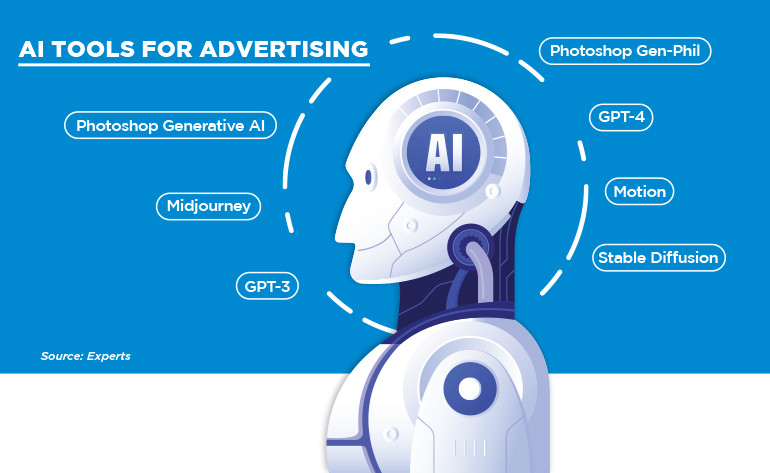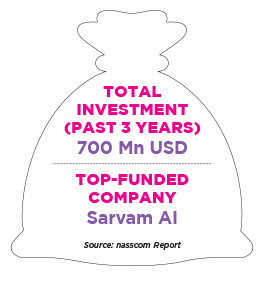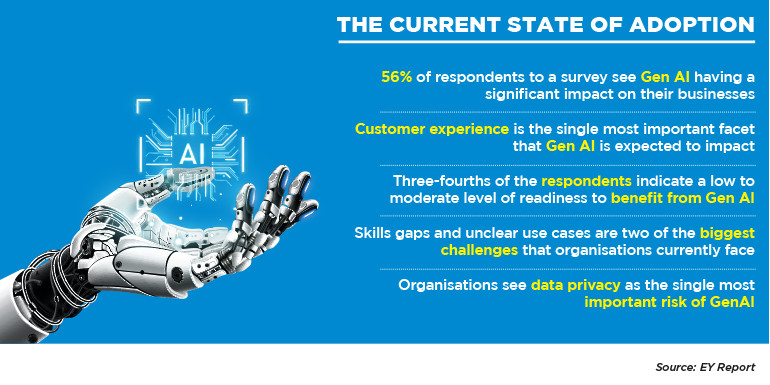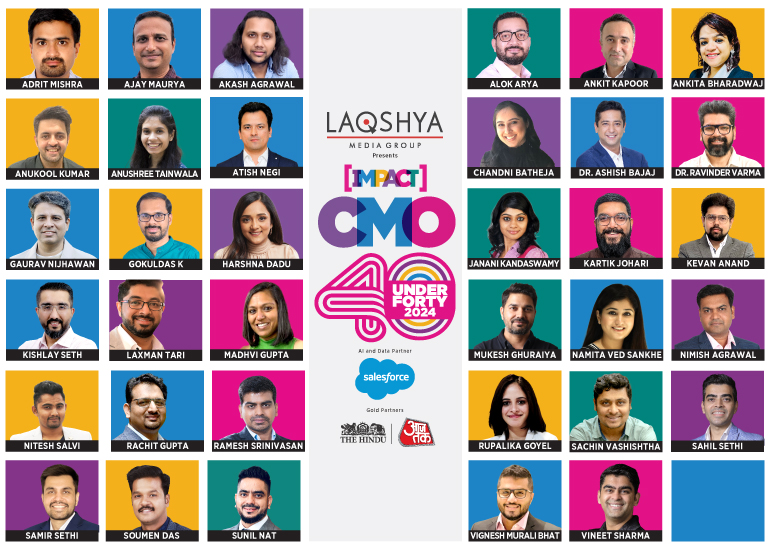The genesis of GenAI can be traced back to the 1950s when polymath Alan Turing introduced the idea of Artificial Intelligence in his paper, ‘Computer Machinery and Intelligence.’ The gravity of the question, ‘Can Machines Think?’ posed by Turning in the paper, is being answered sufficiently today. In the advertising and marketing ecosystem, GenAI has made it easier for marketers to produce visually rich content - high-value production, skilled professionals, advanced resources, and high-end technology are no longer required to produce quality content. Creators on YouTube have even made full-fledged movies using Gen-AI.
The use-case applications of GenAI are surfacing as GenAI technology matures. It is said to have the capability to propel India’s GDP, given its versatility to improve productivity and efficiency across verticals and industries. A report by EY estimates that GenAI could add $1.2-1.5 trillion to India’s GDP in the next 7 years.
The US is currently the AI capital of the world, but the germination of homegrown start-ups and the recent start-up winter funding round has put the focus on the emergence of Indian GenAI companies and its integration into A&M. The Indian tech-startup ecosystem has received the lowest funding in the last five years, but ironically, GenAI start-ups have still been favoured. Sarvam AI, known for Indian language-based LLM secured a funding of 41 Mn USD (highest funding for a GenAI start-up in the year). According to a McKinsey Report, there are over 100 GenAI start-ups in India now, with this ecosystem getting funded with 700 Mn USD in the past 3 years. 2022 is its biggest year with 566 Mn USD, while 2023 secured 144 Mn USD. Marketing is one of the top four value-proposition verticals wherein GenAI can have the most contribution, in terms of use case applications.

 Although, Sangeeta Gupta, Chief Strategy Officer & SVP, nasscom does not believe that the investment is at an exponential rate, she says, “It’s still a very small pie compared to what could be the possible scope of how GenAI start-ups can grow in the country. But the factors driving acceleration and investment are how GenAI has captured the mindset of everybody. Whether it’s the government or enterprises. AI was good, but AI felt a bit esoteric and I am unsure whether AI is for me. Generative AI has a much more democratized thought behind it, and hence, there is much more interest in what it can do for my organization”.
Although, Sangeeta Gupta, Chief Strategy Officer & SVP, nasscom does not believe that the investment is at an exponential rate, she says, “It’s still a very small pie compared to what could be the possible scope of how GenAI start-ups can grow in the country. But the factors driving acceleration and investment are how GenAI has captured the mindset of everybody. Whether it’s the government or enterprises. AI was good, but AI felt a bit esoteric and I am unsure whether AI is for me. Generative AI has a much more democratized thought behind it, and hence, there is much more interest in what it can do for my organization”.
GenAI in Indian A&M has already left its mark on global platforms. The ‘My Cadbury Ad’ ft. Shah Rukh Khan by Mondelez India took home the Grand Prix in the 2023 edition of Cannes Lions. While we’re seeing the emergence of GenAI companies with substantial funding, we’re also seeing advertising agencies having a GenAI unit within the organisation or upskilling current resources and building access to the technology. Harshil Karia, Founder, Schbang, states, “GenAI integration at Schbang started by incorporating Adobe Firefly into the widely-used Adobe design suite for all our designers. We advanced further by introducing our arsenal of 22 tailor-made AI ‘Schbots’, available exclusively for Schbangers. These bots are designed for a wide list of specified tasks, from crafting catchy social media captions to generating insightful questions facilitating team-client alignment. Additionally, we also have subscriptions to all the major Generative AI platforms such as ChatGPT 4, Midjourney, Motion, Stable Diffusion, among others. Our teams undergo specialised training to harness the potential of these platforms, creating diverse content showcased both on client platforms and our platforms.”
Harshil Karia, Founder, Schbang, states, “GenAI integration at Schbang started by incorporating Adobe Firefly into the widely-used Adobe design suite for all our designers. We advanced further by introducing our arsenal of 22 tailor-made AI ‘Schbots’, available exclusively for Schbangers. These bots are designed for a wide list of specified tasks, from crafting catchy social media captions to generating insightful questions facilitating team-client alignment. Additionally, we also have subscriptions to all the major Generative AI platforms such as ChatGPT 4, Midjourney, Motion, Stable Diffusion, among others. Our teams undergo specialised training to harness the potential of these platforms, creating diverse content showcased both on client platforms and our platforms.”
The Generative Infrastructure
While Generative AI was technically invented in the 1950s-60s with chatbots, the introduction of ChatGPT in 2022 as a public forum has put it on the map, followed by visual and voice generation technologies that caught the public attention. Because the technology is still new, a certain degree of ‘amping up the infrastructure’ is also required to set up a GenAI company or build a unit within the organisation. Pepper Content, a mature start-up that houses a GenAI-powered content ecosystem had gotten early access to GPT-3 in 2021 when people neither knew of GenAI nor did they have the basics of prompt engineering. Kishan Panpalia, Founding Team & Head of Business, Pepper Content mentions prompt engineering in existing technology is knowing what input you need to give to extract the desired output. “Initially, the product team at Pepper Content got access to it, and we started learning it ourselves. That was also the time where LLMs as a concept was just coming up, and becoming popular. In the market, there is no talent particularly for GenAI because it’s not a subject you are taught in college. Most of the talent available is people who have hands-on experience with the technology. So, it is an ‘acquired’ skill rather than a ‘taught’ skill. We were one of the earliest players to adopt it in India, and now there is a specialised editorial team at Pepper who use AI plus human talent as a node to get content generated or edited,” he says.
Pepper Content, a mature start-up that houses a GenAI-powered content ecosystem had gotten early access to GPT-3 in 2021 when people neither knew of GenAI nor did they have the basics of prompt engineering. Kishan Panpalia, Founding Team & Head of Business, Pepper Content mentions prompt engineering in existing technology is knowing what input you need to give to extract the desired output. “Initially, the product team at Pepper Content got access to it, and we started learning it ourselves. That was also the time where LLMs as a concept was just coming up, and becoming popular. In the market, there is no talent particularly for GenAI because it’s not a subject you are taught in college. Most of the talent available is people who have hands-on experience with the technology. So, it is an ‘acquired’ skill rather than a ‘taught’ skill. We were one of the earliest players to adopt it in India, and now there is a specialised editorial team at Pepper who use AI plus human talent as a node to get content generated or edited,” he says.
The early days of ad agencies setting up a GenAI unit have been more about building access to GenAI tools, upskilling current resources, and exploring untapped possibilities. For the agency Schbang, it is also about establishing its ubiquity throughout the brand ecosystem, as the broader goal is to make it an integral part of brand operations, maximising efficiency across the board. Trials, tests, and explorations are also an integral part of building GenAI infrastructure, as various organisations use suite-based tools, and with the new addition completely changing the tool kit or adding new ones may affect the workflow. Ambika Sharma, Founder and MD, Pulp Strategy states, “We incorporated Gen-AI in early 2023, and set up an innovation lab with the purpose of testing and running trials on multiple tools. We developed the know-how and ability to use these AI tools to enhance our services and deliver innovative solutions for our clients. Generative AI is being used at multiple points in the workflow, such as research and analytics, visual representation of data, coding, media analytics, UI/UX, video, art, design, photo shoots, etc. Our purpose in incorporating AI is innovation, speed, efficiency, and accuracy, and it must address one or more of the criteria before we incorporate a tool into a full or partial-use pattern.”
Trials, tests, and explorations are also an integral part of building GenAI infrastructure, as various organisations use suite-based tools, and with the new addition completely changing the tool kit or adding new ones may affect the workflow. Ambika Sharma, Founder and MD, Pulp Strategy states, “We incorporated Gen-AI in early 2023, and set up an innovation lab with the purpose of testing and running trials on multiple tools. We developed the know-how and ability to use these AI tools to enhance our services and deliver innovative solutions for our clients. Generative AI is being used at multiple points in the workflow, such as research and analytics, visual representation of data, coding, media analytics, UI/UX, video, art, design, photo shoots, etc. Our purpose in incorporating AI is innovation, speed, efficiency, and accuracy, and it must address one or more of the criteria before we incorporate a tool into a full or partial-use pattern.” Ayush Wadhwa, Founder, OWLED Media, reckons “The workflow involved a crucial workshop that helped us understand the potential of Generative AI and its application in our work culture. Talent acquisition focused on individuals with a keen interest in AI and machine learning, while skill development primarily revolved around hands-on practice. Learning to create better prompts was key, and incorporating Gen-AI into our workflow, such as generating images when stock photos were unavailable, showcased its practical benefits”.
Ayush Wadhwa, Founder, OWLED Media, reckons “The workflow involved a crucial workshop that helped us understand the potential of Generative AI and its application in our work culture. Talent acquisition focused on individuals with a keen interest in AI and machine learning, while skill development primarily revolved around hands-on practice. Learning to create better prompts was key, and incorporating Gen-AI into our workflow, such as generating images when stock photos were unavailable, showcased its practical benefits”. Talent seems to be one of the key factors for GenAI integration, whether it’s acquisition or upskilling, more so because academia is not as accessible for the technology. Venugopal Ganganna, CEO, Langoor Digital says, “We’ve recruited individuals with expertise in AI, machine learning, data science, and related fields. Additionally, we have encouraged collaboration between AI experts and employees who understand the company’s core business to push the envelope with tech and creativity. We also offer training programmes to upskill current employees in relevant areas such as data literacy, AI basics, and machine learning. Our proudest achievement is creating a culture of continuous learning and adaptation to keep pace with rapidly evolving AI technologies — not just on the generative side, but also the predictive AI”.
Talent seems to be one of the key factors for GenAI integration, whether it’s acquisition or upskilling, more so because academia is not as accessible for the technology. Venugopal Ganganna, CEO, Langoor Digital says, “We’ve recruited individuals with expertise in AI, machine learning, data science, and related fields. Additionally, we have encouraged collaboration between AI experts and employees who understand the company’s core business to push the envelope with tech and creativity. We also offer training programmes to upskill current employees in relevant areas such as data literacy, AI basics, and machine learning. Our proudest achievement is creating a culture of continuous learning and adaptation to keep pace with rapidly evolving AI technologies — not just on the generative side, but also the predictive AI”.
The collaborative process runs across the technology industry too. Sumit Singh, CEO & Co-founder, DashLoc, a GenAI-powered Hyperlocal MarTech discovery platform that integrates GenAI into the infrastructure by changing its approach to talent acquisition and resource utilisation, says, “Rather than solely focusing on hiring experts in AI and restructuring existing teams, we opted for a collaborative model. This involved partnering with external AI specialists and leveraging their expertise through consulting agreements and joint projects. Additionally, we implemented a mentorship programme where seasoned AI professionals guided our internal teams, fostering knowledge exchange and skill development.” According to him, this collaborative approach not only accelerated the integration of GenAI but also enriched the organisational culture with diverse perspectives and experiences. galleri5, a Creator Stack that enables a SaaS platform that employs generative AI to automate influencer marketing used the technology on a differentiated arm of marketing. To build the platform, the company sought out individuals with a grasp of mathematics and logical reasoning. Rahul Regulapati, Founder & CEO, galleri5 shares, “Our philosophy is simple – math can unlock new potentials in marketing, like turning creator content into mathematical vectors for sophisticated analysis, generating and recreating visual content. Our platform is also enriched by the marketing team’s real life experiences, managing 1000+ campaigns for a network of 15,000 influencers over 5 years. We’ve distilled insights from these campaigns and real life influencer interactions into our AI, teaching it to understand the nuances of content creation, data analysis, and how marketers manage campaigns”.
galleri5, a Creator Stack that enables a SaaS platform that employs generative AI to automate influencer marketing used the technology on a differentiated arm of marketing. To build the platform, the company sought out individuals with a grasp of mathematics and logical reasoning. Rahul Regulapati, Founder & CEO, galleri5 shares, “Our philosophy is simple – math can unlock new potentials in marketing, like turning creator content into mathematical vectors for sophisticated analysis, generating and recreating visual content. Our platform is also enriched by the marketing team’s real life experiences, managing 1000+ campaigns for a network of 15,000 influencers over 5 years. We’ve distilled insights from these campaigns and real life influencer interactions into our AI, teaching it to understand the nuances of content creation, data analysis, and how marketers manage campaigns”.
GenAI is also growing at an ecosystem level and not just as individual entities. vidz.ai, an AI-driven platform offering video solutions recently partnered with Tonic Worldwide to launch an AI-driven personalised video marketing solution for brands. The collaboration will enable the video content division, Tonic Worldwide Intuitive Programming, to extend customisation and personalisation.
Rajesh Goyal, Co-Founder & Partner, vidz.ai believes that the Gen-AI integration into A&M is an eco-system play. According to him, “While the business-specific application areas should be the core focus for the organisations, partners can bring the required GenAI technologies and plumbing. For instance, we are working with organisations where the LLM (Large Language Models) layer based on their domain knowledge is built by one partner and the expression layer or the experience layer is built by us, while the organization is providing the training datasets required for building this”.
True, the use cases applications of this technology for marketing seem astonishing, but human intervention remains at the core of automation. Vipul Kedia, Chief Data & Platforms Officer, Affle & Head of MAAS reckons, “It’s important to recognise that any AI tool represents a fine balance between technology and human ingenuity. In this transformed landscape, AI handles the repetitive and data-driven aspects of content creation, freeing up human resources to focus on ideation, innovation, and strategy. This symbiotic relationship enhances the overall efficiency of the creative process. AI tools analyze vast datasets, provide valuable insights, and assist in decision-making, enabling humans to make informed and creative choices. Clients benefit from quicker and more cost-effective solutions, saving man hours to sift through large data sets and get more for their ad budgets, while agencies become hubs of creative and strategic innovation to derive growth from these insights.”
Chiming in with this thought, Anand Mahurkar, Founder & CEO, Findability Science says “It is imperative to understand that GenAI technologies act as co-pilots rather than autonomous pilots. They are designed to assist and enhance human expertise, not replace it. In this evolving landscape, agencies must adapt by reimagining their business models to embrace the strengths of AI. An efficient co-pilot can reduce the workload of the pilot, but the pilot’s importance and responsibilities in steering and oversight remain unchanged. This transformation also necessitates client education.”
Mahurkar further stresses that it is vital for clients to recognise that while GenAI can streamline and innovate processes, the strategic direction and decision-making capabilities of human professionals are irreplaceable”.

The Generative Integration
The value proposition of Generative AI holds extensive potential for the A&M industry. Talking about the current use-case applications, Karia states that currently it’s being used for text and visual generation merged with human creativity. He adds, “Another major category is customising and training bots as well as building customer service bots for clients. Moreover, we are pioneering creative innovations in text-to-video AI, presenting groundbreaking campaigns set for the upcoming award season. Beyond that, our strategic use of AI extends to defining and addressing complex social questions on behalf of brands.” Karia notes that AI is not only shaping content for Schbang but also contributing to its way of working as evidenced by the 22 customized Schbots. The next stage for the organisation is to do this customization inside of company landscapes.
He further explains that these Schbots are a collection of custom-made AI bots designed by Schbang, aimed at enhancing marketing efforts across various stages.
Usage of GenAI apart from creative generation is currently uncharted territory, but we see more use cases as the technology matures. Regulapati says Gen-AI is used primarily in content generation and analysis, but it’s also being used to make influencer marketing more tailored with recommendation engines for influencer and brand matchmaking; understanding fashion elements with ‘Fashion Finder’; and tracking trends before they become mainstream. Wadhwa on the other hand shares that its use spans across text-based creation, virtual assistance, and visual generation. He says, “We majorly use visual generation tools like Midjourney and Photoshop Gen-Phil that operate based on prompts that are provided. More recently, GPT-4 has also integrated text-based Gen-AI, combining algorithms from GPT-3 with visuals. The core idea remains rooted in providing a prompt to yield desired results. Gen-AI streamlines processes, offering quicker ideation and execution, enabling the realisation of ideas that might be challenging or expensive to execute traditionally”.
Dipankar Mukherjee, Chief Innovation Officer, Nihilent Ltd. says that with GenAI, the company has identified priority use cases, focusing on content creation, workflow automation, and personalisation of CX journeys. He says, “We initiated an internal ‘promptathon’ to unearth the top AI Whisperers in each function. Champions were selected from the creative, development, pre-sales, and strategy departments. On August 15, 2023, our team unveiled India’s inaugural Generative AI music video, showcasing our freedom fighters singing the national anthem. By the first quarter of 2023, we achieved nearly 75% adoption of Generative AI throughout the organisation.” He further goes on to say, “It was a unique project - we used existing archival recordings of their speech, and trained the model to imagine their singing voice”.
The human intervention in Gen-AI-powered content is also an exceptional concern since several of the GenAI tools are trained on previous data which include human shortcomings and biases. At the same time, monitoring and merging the content with human intelligence is also important until sophisticated established tools are inaccessible. Panpalia shares that along with text-based creation, it’s also being used to create thought leadership content of persona, where GenAI is just used as a method to make creative, and then more data and insights are added by the human.
A few differentiated use cases are also cropping up for Gen-AI within marketing. Currently, we have primarily seen the technology’s use for creating multiple versions of an ad film, or AI-imagined content that’s converted from text prompts to visual images. But there are also several use cases beyond the creative landscape and into strategic or operational effectiveness.
The change in the execution model and the client-agency relationship is a growing concern. However, Goyal believes that the agency model to develop and execute marketing campaigns and strategies for the client will not change. According to him, clients and agencies will leverage this tech innovation.
Speaking of the slate of GenAI tools that can bolster marketing strategies on both back and front-ends, Singh shares that Generative AI tools relevant to the advertising and media industry include platforms such as OpenAI’s GPT-3, DALL-E, and CLIP. Singh states that DashLoc harnesses Gen-AI’s power for Search Engine Optimization (SEO), Lead Generation Optimization, and Customer Engagement Enhancement.
Personalisation is the name of the game when it comes to GenAI’s capabilities to create a campaign for a hyper-targeted consumer with elements tailored down to its detail. Mahesh Narayanan, Chief Marketing Growth Officer, Netcore Cloud shares, “Our Gen-AI tools streamline campaign workflows, ensuring precise audience targeting and facilitating end-to-end marketing campaigns. Brands benefit from personalised real-time search and discovery experiences for consumers. Our sophisticated algorithms analyze demographics, browsing behaviour, recent purchases, and affinities to enhance understanding of shopper intent, dynamically curating results aligned with preferences. This versatility empowers brands to enhance marketing efforts across various categories, elevating consumer engagement, fostering loyalty, and delivering an efficient and enjoyable shopping experience with hyper-personalized results”.
Gen-AI is not just being used for the end consumer or the client. Anuj Krishna, Co-founder and President – Technology and Growth, MathCo says, “Most of the use cases we are building for customers are in the area of parsing information and text-based summarization. A lot of the use cases are more focused toward the internal workings of the organisation rather than end customers given the possible liability involved in exposing to end customers without a clear understanding of the capability”.
Such use cases are also helping to cut cost at various levels, whether it’s internal people management or consumer experiences. Anuradha Sehgal, Chief Marketing Officer, Coforge states, “We currently have multiple pilot programmes underway, addressing use cases such as cost optimization, efficiency improvement, productivity enhancement, and customer experience elevation. These initiatives have yielded impressive results, leading to a productivity increase of 15-20%. Moreover, we’ve achieved cost efficiencies ranging from 25-35%, accompanied by a significant reduction in error rates across various applications to just 5% of their previous levels. The implementation of Gen AI models in the realm of customer experience has resulted in a substantial 30% reduction in in-person contact, contributing to an overall enhancement of the customer journey”.
Although, the industry is not stopping at cost-cutting, it is using this technology to pave a path for long-term revenue growth, streamlining profit generation, and going beyond cost efficiency. Kedia states, “We recently filed 15 new patents in India that cover futuristic applications in interaction, training, and integration of GenAI agents. The patents span advanced AI areas such as personalization, recommendation systems, predictive analysis, privacy, and enhanced fraud detection. Our goal is to also enhance the learning and application of GenAI to several use cases across connected devices.”
Rashi Agarwal, Founder, Megalodon believes that the trick is to amalgamate CGI with AI, something that people have not yet experimented with. She says, “As a founder of Megalodon, my biggest challenge is to keep up with the time. I think every day there is something new happening.” Speaking of GenAI’s value driven proposition she further says, “Some brands are conventional in their approach. If 10 lakh INR is the budget for a brand video, with AI, it’s at 1/10th of that cost. That’s the amount of value driven proposition that we are talking about.” However, she warns that the GenAI brain is dependable on the data that it has been fed, and not everything is verified. She concludes by saying, “AI at the end of the day is supposed to be treated as your supporting hand.”

Generating Benefits
The current metrics are showing promising numbers for creatives developed using GenAI. Karia states, “For Britannia, our regular creatives typically achieved an engagement rate of around 6%. However, GenAI creatives surpassed expectations, nearly doubling that rate at just above 11%. Similarly, in the case of Crompton, regular creatives recorded a 5% engagement rate. But when we introduced Gen-AI for creatives, the engagement rate elevated significantly to 9%”.
The blessings of GenAI are not just restricted to engagement rate, it also helps in conversion and sales. Regulapati too have experienced the same, stating that campaigns developed using GenAI at galleri5 have shown better performance in terms of higher impressions than those selected through manual selection. Naturally, brands are also welcoming creative effectiveness with open arms. Binit Kumar, DGM - Marketing, Dabur India Limited, states “Being dull in business and marketing is costly and frustrating. You have to put a lot of effort and money into making a message clear to others. AI & CGI-led technology can make the dull interesting. The Pulp Strategy team made the process joyful; we were pleased with the output and how smoothly it sailed through”.
Naturally, brands are also welcoming creative effectiveness with open arms. Binit Kumar, DGM - Marketing, Dabur India Limited, states “Being dull in business and marketing is costly and frustrating. You have to put a lot of effort and money into making a message clear to others. AI & CGI-led technology can make the dull interesting. The Pulp Strategy team made the process joyful; we were pleased with the output and how smoothly it sailed through”. Creative partnerships are boosting GenAI in use and unlocking new efficient ways. Pragya Bijalwan, VP - Marketing, Crompton Greaves Consumer Electricals Limited shares, “Gen AI allows the brand to enhance creativity, brings speed, personalisation, and efficiency through innovative solutions. A collaboration with expert agency partners on that front helps the brand generate the right content, keeping it dynamic as well. We use GenAI extensively on topical creatives with Schbang as the conversation needs to be relevant, engaging, and quick. We are in the consumer electricals industry where product imagery plays a big role. Our agency partners have used GenAI to bring out the beauty in the product in the most interesting manner, drawing the consumers’ attention. The results are evident in our engagement scores on social media which remains the industry best”.
Creative partnerships are boosting GenAI in use and unlocking new efficient ways. Pragya Bijalwan, VP - Marketing, Crompton Greaves Consumer Electricals Limited shares, “Gen AI allows the brand to enhance creativity, brings speed, personalisation, and efficiency through innovative solutions. A collaboration with expert agency partners on that front helps the brand generate the right content, keeping it dynamic as well. We use GenAI extensively on topical creatives with Schbang as the conversation needs to be relevant, engaging, and quick. We are in the consumer electricals industry where product imagery plays a big role. Our agency partners have used GenAI to bring out the beauty in the product in the most interesting manner, drawing the consumers’ attention. The results are evident in our engagement scores on social media which remains the industry best”.
With substantial investment in the sector, fast-paced adoption of the technology in the A&M industry, and positive reception by brands, we are looking forward to a new and exciting homegrown chapter of Generative India.
AI FRONTRUNNERS IN INDIA
Company: Nihilent Ltd.
Profile: Using a Design Thinking framework for innovation and problem-solving, Nihilent offers a comprehensive range of expertise in process and tech to facilitate business transformation.

“We had several large technology squads already engaged in AI, ML, Computer Vision, and Generative Adversarial Networks long before GPTs and OpenAI gained prominence. However, in 2022, the emergence of the first public LLMs highlighted the need for a comprehensive organisational adoption and understanding of Generative AI.”
Dipankar Mukherjee
Chief Innovation Officer, Nihilent Ltd.
Company: Coforge
Profile: Coforge is a global digital services and solutions provider, that leverages emerging technologies and deep domain expertise to deliver real-world business impact for its clients.

“We currently have multiple pilot programmes underway, addressing use cases such as cost optimisation, efficiency improvement, productivity enhancement, and customer experience elevation. Encouragingly, these initiatives have yielded impressive results, manifesting in a notable productivity increase of 15-20%, leading to superior people management and enhanced time utilisation.”
Anuradha Sehgal
Chief Marketing Officer, Coforge
Company: Math Co.
Profile: TheMathCompany, founded in 2016, is a global Enterprise AI and Analytics company, trusted for data-driven decision making by some of the largest organizations across industries.

“GenAI is a foundational capability that large organisations are building and hence, there is ample space for start-ups to capitalize on this trend. MathCo is focused on helping large Fortune 500 organisations with defining their GenAI strategy, building custom applications to solve business problems infused with the technology and creating foundational elements that will help solve multiple problems.”
Anuj Krishna
Co-founder and President – Technology and Growth, MathCo
Company: Megalodon
Profile: Megalodon is a super-specialised creative tech company which stands at the forefront of Communications and Marketing innovation in India.

“At Megalodon, we bring a unique blend of dynamic creativity and innovative communication methods that have been helping brands with great impact parameters, increased visibility and engagement, viral content and reduced marketing costs. We transcend traditional boundaries in brand communication through the dynamic synergy of AI and tech.”
Rashi Agarwal
Founder, Megalodon
Company: Pepper Content
Profile: An AI co-pilot, Pepper Content combines the power of strategic content consulting, technology, and expert human talent to help enterprises solve the content marketing problem across Search, Social, YouTube, CRM, and Owned Assets.

“In the next leg of our journey at Pepper, we are scaling workflows on the top of generative AI by building custom LLM models trained on brand data for context, embedding human + AI mode of creation, and scaling multi-modal content. The GenAI space has seen a fascination curve that has now plateaued at building custom application layers for enterprises and Pepper now wants to ride that wave. In simple language, we will be now building AI blocks, which along with Human Talent, depending on customer needs will be joined together, building a truly Content Transformation Engine”
Kishan Panpalia
Founding Team, Pepper Content
Company: Findability Sciences
Profile: Findability Sciences is an expert AI Product and Solution provider, with a keen focus on facilitating traditional enterprises in harnessing the power of data and cutting-edge AI technologies.

“Findability Sciences’ Business Process Co-Pilots revolutionize information extraction from a multitude of text sources, including reports, documents, emails, social media commentary, and chat transcripts with our cutting-edge technology. In March 2024, for the second year running, Findability Sciences has been honoured on Fortune’s esteemed list of America’s Most Innovative Companies for 2024. This back-to-back recognition highlights the company’s relentless pursuit of innovation and its consistent contribution to advancing the AI technology landscape.”
Anand Mahurkar
Founder & CEO, Findability Sciences
Company: Affle
Profile: Affle is a global technology company with a proprietary consumer intelligence platform that transforms ads into recommendations helping marketers to effectively identify, engage, acquire and drive transactions with their potential and existing users.

“At Affle, our focus lies on leveraging GenAI to revolutionise advertising. While the industry has been largely using GenAI for optimizing human capital and cost, our focus has been to harness GenAI’s potential to go beyond cost efficiency to enable long-term revenue growth and a competitive edge. We aim to expand GenAI’s reach across connected devices and are already using it in some of our key offerings such as the GenAI-powered multilingual keyword recommendation tool for our Apple Search Ads Platform.”
Vipul Kedia
Chief Data & Platforms Officer, Affle
Company: DashLoc
Profile: A hyperlocal MarTech discovery platform, DashLoc harnesses GenAI to enhance brand visibility and improve user experience. By analyzing user intent and content signals, GenAI optimizes brand visibility in search results, increasing traffic.

“DasLoc was founded in 2020 with a focus on cutting-edge technology, cost-effectiveness, and comprehensive support to brands, eliminating the need for additional personnel. Its USP lies in its cutting-edge technology, cost-effectiveness, and comprehensive support to brands, eliminating the need for additional personnel. The brand’s GenAI-enabled solution and micro-level optimization set it apart, offering a unique dashboard for efficient management. It provides a 3-step approach - Search visibility for the local community, MOM growth on lead, and customer engagement.”
Sumit Singh
CEO and Co-Founder, DashLoc
Company: Vidzai Digital Inc.
Profile: Vidzai boasts storytellers who transform the end Customer’s experience on the enterprise’s marketing messages. Presently, it is working on Generating visuals, synthesizing voice, and streamlining video production with Gen AI.

“At Vidzai, we are making giant advancements in the field of GenAI. At present, the core work revolves around generating visuals, synthesizing voice, and streamlining video production. We transform the end customer’s experience on the organisational message, by making each of these ‘in-context’ and ‘conversational’ 1:1 video messages.”
Rajesh Goyal
Partner, Vidzai Digital Inc.
Company: Netcore Cloud
Profile: Netcore Cloud, a global leader in marketing technology, empowers marketers with its comprehensive Customer Engagement and Experience Suite to create personalized experiences across digital channels such as Web, Email, App Notifications, WhatsApp, SMS, and RCS. Leveraging AI to integrate customer data, Netcore enables targeted segments and meaningful digital interactions.

“Generative AI is transforming marketing by enhancing creativity and enabling greater personalisation. At Netcore, our Gen AI Co-Marketer is helping esteemed brands like Crocs, Biba, and Plum Goodness improve how they connect with their consumers. By optimizing product recommendations, these brands increased their Average Order Value (AOV) by 20% and boosted overall conversion rates by up to 15%. Using Gen AI, we can derive category and brand affinity for d2c e-commerce and retail brands, thereby substantially boosting their CRM campaign conversion rates.”
Mahesh Narayanan
Chief Marketing Growth Officer, Netcore Cloud
























